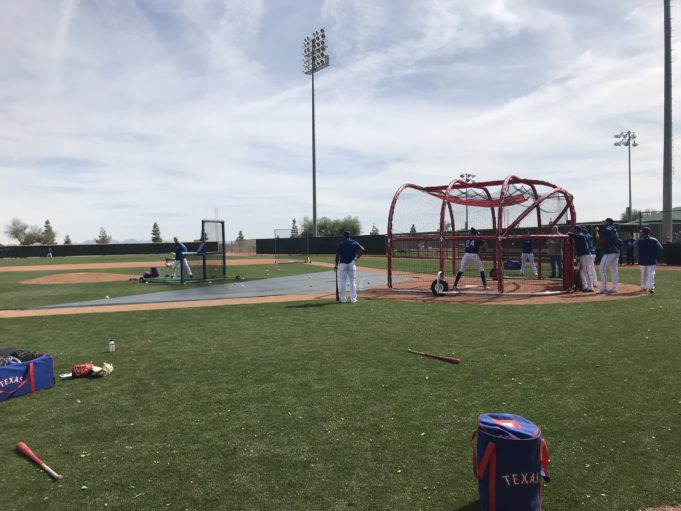Major League Baseball’s trading deadline presents an interesting contrast between short- and long-term planning. Some teams decide to go for a title over the ensuing two or, they hope, three months. Others abandon aspirations of winning anything in the current season and acquire assets they envision helping them in future seasons. In an article I did for the print side of the Fort Worth Weekly this week (pick up a copy today), I looked at a bit of what happened on July 31 this year. But in the spirit of the deadline, I felt I should also blog about the long term. What will happen next year?
This year, the big change came to the ways teams can make trades. It used to be that a team could deal any player without no-trade protection prior to July 31. They could also move a player after that date if he cleared waivers. Teams would put each player on their rosters through waivers. Every other team in the league would have a chance to claim him, and the original team could either give him to the claiming team (who would now have pay the player’s full salary), trade him to that team, or pull him back off waivers and not be able to trade him again until the offseason. We’ve seen big names like Justin Verlander, Iván Rodríguez, Adrián González, Carl Crawford, John Smoltz, Jeff Bagwell and new Hall of Famer Harold Baines (Rangers to A’s, Aug 29, 1990 for Joe Bitker and Scott Chiamparino) change hands in August. That can’t happen any more.
Another development in recent years has been in the way teams view prospects. Building a team through a farm system is now considered an efficient way to compete and front offices have become increasingly hesitant to give up young talent for short-run rental players. Traditional deadline buyers like the Yankees and Dodgers, among others, declined to acquire veterans for minor leaguers this July. How that works out for them, and the teams who unsuccessfully asked for the big clubs’ best prospects in deals, could affect how both buyers and sellers view future deadlines.
When one could still acquire players in August via trade, there was a little bit of a cushion for contending front offices. Even if you didn’t make deals at the deadline, you knew you could counter a key August injury by at least bringing in somebody with big league experience. If a team with a World-Series-or-bust fan base (like the Yankees or Dodgers) suffers a key injury this August that leads to crippling lack of late-season depth, it will be interesting to see if that team seems determined to make a deal in 2020 to avoid a repeat.
Next season’s deadline generates particular interest because roster rules will change. All season teams can carry 26 players instead of the current 25. In September, active rosters can expand to 28 per team. The current rule allows a team to add any member of its 40-man roster to the big league squad during the season’s last month. I’ll explain why I don’t like the rule change later, but first, here are some areas it might affect:
- Pro Scouts – what will the pro scouts do in August? They won’t spend much time looking for potential trade acquisitions, since trades can’t be made. Contending teams can certainly put more sets of eyes on potential postseason opponents. Non-contending teams might assign them to look at potential offseason free agent acquisitions, scout minor league Rule 5 draft possibilities, or wash the general manager’s Lexus.
- Front Office Focus – For teams unlikely to make the postseason, their entire focus becomes their system the following year, because they can’t even trade veterans the last two months. Roster management will become even more crucial than it already was, because they only have 28 active spots to work with. If they want to see how a number of their AAA players perform the last month, they can’t have all of them up at one time – unless they release people, which brings us to:
- Veterans – The Rangers cut Asdrubal Cabrera loose after the deadline. We should expect to see even more of that sort of move in 2020. A veteran who isn’t a star and whose contract expires at the end of the year will be on thin ice for keeping his roster spot on an out-of-it team. It used to be that a franchise could keep him around and just minimize his playing time. They had to pay him anyway, and somebody on a contender who plays his position might get hurt and he could be turned into an asset. Not only can he no longer be traded in August or September, his active roster spot is a lot more valuable than it used to be because you can only have 28 in the clubhouse. Don’t feel badly for the veterans cut loose by this strategy. They still get paid and now have the freedom to join an interested contender without their old club having to negotiate trade terms.
- Arizona and Florida – We might see each contender send a handful of AA and AAA players to their spring training complexes to work with instructors after minor league seasons end. It used to be that you could bring up anybody you thought you might need in September to the big leagues. Now they’ll have to have somewhere else to try to stay sharp.
So those are a few of the issues clubs will have to address with the September roster rules change. Now, you’re wondering, why don’t I like the change?
First let me say that I like and respect Doug Melvin a lot, and he advocated for this adjustment (I just am not on board with it). One of his concerns was that small-market clubs couldn’t afford to expand their rosters the way big-market clubs could. My take on that is that if teams can’t add several minimum-salaried players to their rosters for a month, the problem is revenue-sharing. It has clearly failed and needs to be re-adjusted so they can afford this (relatively) minor expense. We’re not trying to enable them to sign Giancarlo Stanton here (although, come to think of it, it was Miami who gave him that size-of-the-known-universe contract).
Expanded September rosters should be a boon for teams out of the race, which usually includes a lot of the poorer teams, because they can give their prospects experience while evaluating them. That should give them a long-term advantage, however slight, on the teams who have to put a veteran lineup on the field every night. That, by the way, is what I love about September roster expansions. It gives the fans, especially the die-hards, something to get interested in when their team’s 20 games out and falling. It’s a lot more interesting seeing the potential phenoms take some hacks than the guys who landed you in last place in the first place (did I really just write that?).
Some argue that it’s not right to play by one set of rules for five months and then switch for the sixth. Well, guess what – there are lots of times when the rules are different. The most obvious is that in September, no matter what the roster rules are, there are no minor league seasons going for most of the month. So if you need an in-form player to replace an injured frontliner, you can’t grab him from your AAA affiliate because they aren’t playing. And it’s even more difficult now that you can’t make a trade for a replacement in the last two months.
What are some other places the rules are different, you ask? How about the postseason? Here, too, there are no active high-level minor league teams from which to draw players. And your active roster can’t be changed from series to series (anywhere from three to seven games), save for an injury (which removes the injured player for the next series, too). That’s different from the regular year when you can adjust from game to game. That’s especially important from a pitching perspective. If your long reliever goes a bunch of innings in the regular year, you can send somebody down to the minor leagues and bring up a fresh arm. You can’t in October.
Other places the rules change? When teams play overseas to open a season, they get extra spring training. When there’s a World Baseball Classic, clubs lose some of their players and have to alter their season preparations accordingly. When there’s a doubleheader, we now add an extra player to each team’s roster for the day. Some teams’ have AAA affiliates further away than others. That affects how they can manage their rosters. You can get a guy to Arlington quicker from Round Rock than you can from Nashville. Back in the day, some teams even used to play in-season exhibition games, like the Hall of Fame Game. So the idea that April-August roster rules are somehow sacrosanct seems hollow to me.
I also think you can use expanded rosters to prevent overuse injuries in pitchers. Another way September is different than the other months is that by then they’ve played five months of baseball already. Give your workhorses a break by spreading some innings around. One would speculate that injuries are reduced, and fresher arms in the postseason make for a better quality of play during a period when MLB makes a lot of cash.
2020 will be an interesting year in baseball. Whether it will be better because of the new roster rules remains to be seen.












